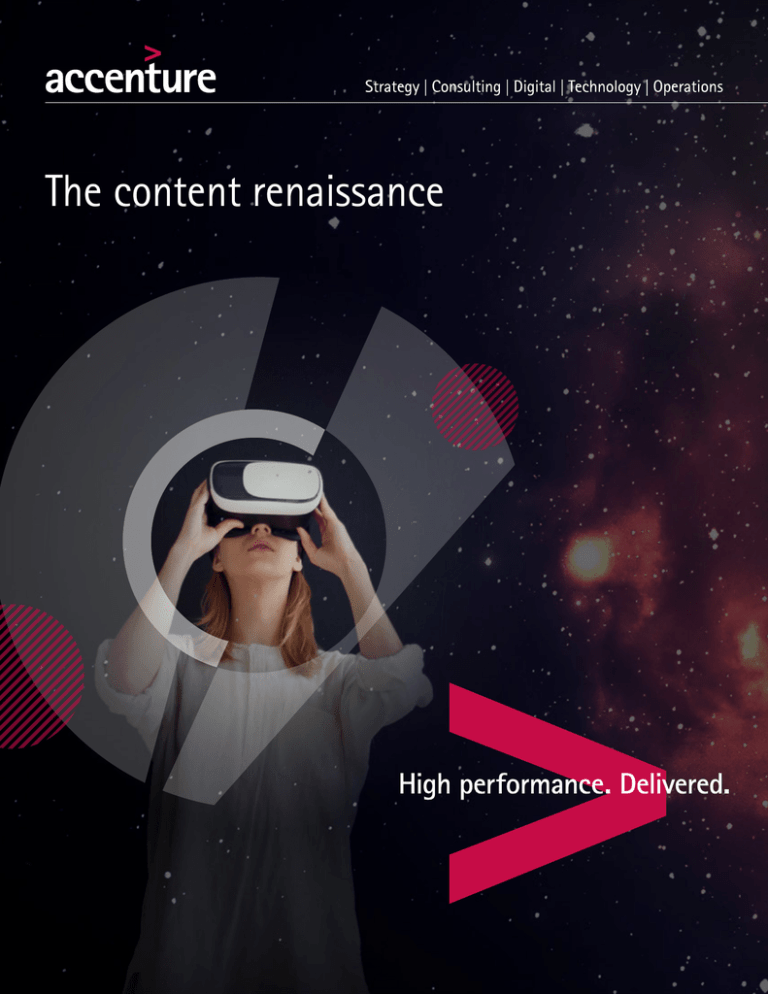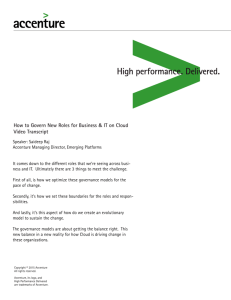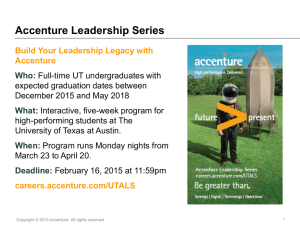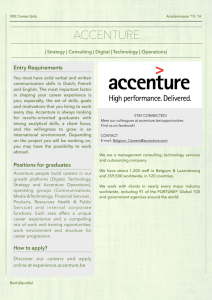
The content renaissance
New technologies are democratizing content
Content is being democratized. Advances in technology have enabled
more and more consumers to produce and distribute new content.
Everyone and anyone can now be a content producer, using improved
technology to find new ways of sharing their interests and telling their
stories. This trend is driven by better, cheaper and more widely-available
technology for the capture and editing of video content, and by the
number of different distribution channels open to new and established
content producers. The emergence of exciting new forms of immersive
and holographic video experience is a part of this story, too. In this
evolving environment, in which consumers have a more diverse set of
associations with different forms of content and different distribution
channels, there may be new opportunities for content providers to
monetize niche channels and markets.
Everyone can be a video star
There are over a billion YouTube users worldwide. Every
day more than 300 hours of video are uploaded to the
service, and people watch hundreds of millions of hours
of content on the channel. This explosion in the amount
of video online is driven by individuals’ desire to share
their stories and interests with the world. But this isn’t
just about altruism: YouTube content can earn its
producers an income as well. More than a million
YouTube channels, in dozens of countries, are earning
revenue through YouTube’s Partner Program. This
program enables content creators to monetize their
2
videos in a number of different ways, including
advertisements, paid subscriptions and merchandise.
Partners can earn an income from these ads and fees, and
can track and manage their videos’ performance using
YouTube analytics. YouTube also provides a number of
“Spaces” in major cities around the world, which offer
production facilities, workshops, and other opportunities
for collaboration. Creators filming in these Spaces have
produced over 10,000 videos which have generated over
a billion views and more than 70 million hours of
watching time.
This kind of content democratization has been partly
driven by advances in technology. An averagely-priced
smartphone now contains video-capture technology of a
standard that would, just a few years ago, have far
exceeded the reach of most consumers. Better editing
software, usually also available on a smartphone, has
made a major difference too. But this is more than just a
technology story; the democratization of content is as
much about what is being created as how it’s being
created. A world in which anyone can produce and
distribute video content at a relatively low cost is a world
The unidentified woman behind the DisneyCollectorBR
in which ideas of every conceivable type can be tested in
YouTube channel, who produces and distributes “unboxing” the marketplace. Unchained from traditional
videos of Disney products, is another high-earning YouTube considerations about mass-market appeal, and released
celebrity. The remarkable unboxing phenomenon, in which from any need to meet revenue projections, content
millions of people watch videos of an often unseen,
producers are free to explore niche areas. But what may
unnamed person opening the boxes of various products
appear to be niche in one breath can turn out to be
and demonstrating the contents – anything from expensive global in the next. Who would have foreseen the
shoes to Bic pens – has captured the public imagination.
popularity of unboxing videos, for example?
Advertising revenue from the DisneyCollectorBR channel
alone was reported to be nearly US$5 million in 2014.
A YouTube channel can be a lucrative earner for a
content producer who is able to catch the zeitgeist. Felix
Kjellberg, better known as PewDiePie, is a 25-year-old
YouTube star who produces videos from his base in
Brighton in the UK. His channel, through which he
distributes “let’s play” videos (commentaries as he plays
video games), has almost 40 million subscribers and
earned an astonishing US$12 million before tax in 2015.
Kjellberg is currently the highest-earning content
producer on YouTube.
New channels, new rules
YouTube isn’t the only channel to have realized the
power of giving content producers creative freedom to
explore new ideas and new formats. OTT distribution
channels, like Netflix and Amazon Prime, are doing the
same with established directors, actors and comedians.
Freed from a need to chase ratings, these OTT channels
are able to give content producers greater license to
deliver the kind of high-quality content that consumers
increasingly want to watch.
Amazon Studios demonstrated its commitment to creative
commissioning when it contracted with Woody Allen to
write and direct a full season of as-yet-untitled 30-minute
shows; the first time that the critically-acclaimed director
will have worked on a television series. A number of
celebrities, including Miley Cyrus, have signed up to work
on the series, which will be exclusively available on
Amazon Prime in the US, UK and Germany.
3
Netflix also sees the value in giving a celebrity room to
develop an idea. Parks and Recreation star Aziz Ansari
decided to launch his latest 10-part show, Master of None,
exclusively on the channel in November 2015. This
critically-acclaimed offbeat comedy drama was
recommissioned for a second series which will air in 2017.
Jerry Seinfeld’s decision to take his most recent idea to
Sony’s online channel Crackle, citing both the creative
freedom and the simplicity of working with a digital
streaming channel rather than a traditional television
network, is another example of this trend. Seinfeld’s
series of shorts, titled Comedians in Cars Getting Coffee,
reached 100 million Crackle views in a single month.
This explosion in creativity is driven by the willingness of
OTT channels to make major investments in original
4
content. Netflix’s spend on original content now makes
up 20 percent of its total content expenditure, and it
spends more than both HBO and Discovery, as well as
outspending the BBC on content overall. Amazon is
spending significant amounts on content, too. The
company recently made a major investment in a
motoring show called The Grand Tour fronted by former
Top Gear stars Jeremy Clarkson, Richard Hammond and
James May. The show, comprising 36 episodes over three
years, will stream exclusively on Amazon Prime.
OTT channels also continue to break established content
procurement rules. When Netflix first decided to produce
its award-winning series House of Cards, it ignored
industry norms and commissioned two entire series at
the outset. A more traditionally-minded company might
have only ordered a pilot episode or, at most, a single
season. In a similar vein, the company recently
announced that its popular comedy series Orange Is the
New Black, currently in its fourth season, had been
renewed for a further three seasons. These multi-season
commissions give creative teams greater freedom to
develop longer story arcs and allow narratives to develop
at a more natural pace.
The use of original content to differentiate OTT
subscriptions is no longer a purely North American
phenomenon either. The trend has emerged in the Asia
Pacific region and is now being seen in Europe. Chinese
OTT services like Youku Tudou and iQiyi have been
developing their own content in recent years. Youku
Tudou made a significant pivot toward original content
development when it launched a new business unit,
Heyi Studios, which now produces original TV drama
and other online-only content. In Europe, Amazon has
ordered its first original German-language television
series, provisionally titled Wanted, which will be made
available on the company’s SVoD service in Germany
and Austria next year. This trend is likely to continue,
especially if the European Commission push forward
with new rules to ensure at least 20 percent of online
content streamed in the European Union originates
from within the EU. The Commission’s proposals, which
are still to be approved, are designed to bring the rules
for digital on-demand and streaming services into line
with those for traditional broadcasters.
5
6
Creative possibilities
There are now endless possibilities for creative content. The
number of different ways to express an idea and reach a
large audience means there’s never been a better time to
create and consume content. New forms of storytelling are
emerging – augmented and immersive experiences –
driven by advances in camera and viewing technology.
Virtual-reality and immersive experiences are already an
established trend. Since launching 360-degree interactive
videos as an experiment last year, YouTube has seen this
form of content gain momentum: the number of
360-degree videos on the service doubled in just three
months this year. The supporting technology is still
evolving, however, and improved, higher-definition
experiences are just around the corner. Samsung’s ‘Project
Beyond’ is a compact, portable 3D ‘omniview’ camera
which, when coupled with its ‘Gear VR’ (an Oculus-like
viewing device) will offer an immersive 360-degree
viewing experience in UHD stereoscopic 3D. When
launched, the camera will be small enough to be taken
nearly everywhere and will allow real-time streaming: the
creative possibilities for, say, streaming live cultural events,
are easy to imagine.
Other technology that just a few years ago might have
seemed like science fiction is becoming a reality. The
Microsoft HoloLens is the first fully self-contained,
holographic computer, enabling users to interact with
high-definition holograms, using gestures, gaze, and voice.
This kind of technology opens up a new world of
possibilities for both consumers and businesses in the
creative and industrial spheres. Creatives and designers are
able to build and model prototypes in a cost-effective 3D
space. One person’s HoloLens environment can be shared
with many others, with exciting implications for education,
medicine, and customer service support. And the HoloLens
can be used to augment real spaces, meaning consumers
can interact with appliances and other devices around the
home, for example, and businesses can include new forms
of field research and simulations for scientific or
commercial gain.
Monetizing a diverse content landscape
This multitude of new ways to produce and consume
video experiences is driving a content renaissance.
Consumers want high-quality content, and are happy to
follow their favorite stars to whichever channel or
technology offers them the best experience for
consuming it. Interests are arguably becoming more
specialized, and so are the channels and forms of content
that serve them. In this rapidly-evolving environment,
there’s an emerging opportunity for providers to
monetize content in specific channels and markets.
Amazon’s acquisition of streaming site Twitch is a recent
example. That service, purchased for US$970 million in
2014, allows users to watch other people playing video
games. A niche interest? Not at all: the service reached
over 55 million unique monthly views. Content providers
need to make sure they are carefully attuned to this kind
of emerging trend. Opportunities may be nascent, or may
not even yet have been conceived of. New forms of
content, and new ways of experiencing it, will certainly
emerge. We are living in a golden age of possibility for
creators, distributors and consumers of high-quality
content.
7
About Accenture
Authors
Accenture is a leading global professional
services company, providing a broad
range of services and solutions in
strategy, consulting, digital, technology
and operations. Combining unmatched
experience and specialized skills across
more than 40 industries and all business
functions—underpinned by the world’s
largest delivery network—Accenture
works at the intersection of business and
technology to help clients improve their
performance and create sustainable value
for their stakeholders. With more than
375,000 people serving clients in more than
120 countries, Accenture drives innovation
to improve the way the world works and
lives. Visit us at www.accenture.com.
Raffaella Masoero
Accenture Media & Entertainment
Managing Director
Copyright © 2016 Accenture
All rights reserved.
Accenture, its logo and
High Performance Delivered
are trademarks of Accenture.
Bikash Mishra
Accenture Media & Entertainment
Strategy Senior Manager
To learn more, please visit
www.accenture.com/pulseofmedia
Join the conversation
#pulseofmedia
This document is produced by consultants at Accenture as general guidance.
It is not intended to provide specific advice on your circumstances. If you
require advice or further details on any matters referred to, please contact
your Accenture representative.
This document makes descriptive reference to trademarks that may be owned
by others. The use of such trademarks herein is not an assertion of ownership
of such trademarks by Accenture and is not intended to represent or imply
the existence of an association between Accenture and the lawful owners of
such trademarks.



